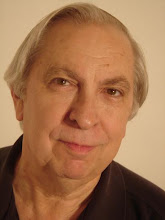One weekend, I really, really wanted to make a no-budget science-fiction short movie set in outer space. But all I had available was a kitchen table, a digital video camera, a webcam, a few still photographs of the moon, some ski clothes, several pieces of outdated electronics gear, some Christmas lights, and the ability to generate cheesy sound effects and weird music.
Obviously, I couldn't go into the "future" with such a motley collection of junk. I would have to create a short movie that is set in the fairly recent past. Some of the electronics gear had been new in the late 1970s. So that became the timeline: a Seventies' sci-fi tale.
I would boldly go where I had no other choice to go.
One other problem: I had no cast and no crew. I would have to do it all myself, including acting. And, naturally, I look nothing at all like someone who would get sent into space. (Except, perhaps, to get rid of me.)
But, I persisted. I piled up all of the junk on the table and stared at it for a long while (wondering if I was insane). Then I started scribbling a little script.
Maybe, I decided, if I arranged the electronics gear a certain way and used the cheap little webcam to capture some video images, I could simulate being in space. Sort of?
So that's what I did. First, I shot some short, closeup clips of the electronics gear, using a cheap little Canon ZR-500 miniDV camera. Then I stacked the gear up on the table.
To simulate a camera in a space capsule, I used a very basic webcam and tried to pretend to be an astronaut while wearing some old ski clothes. I did not, of course, receive any Academy Award nominations for my performance.
The only way I could simulate weightlessness was to use a radio microphone with a fairly stiff, coiled cord. I could shove it into view from just off camera and catch it just as the coiled cord lost tension and the microphone seemed to float toward my hand.
The moon and Earth pictures were public domain. I printed out some moon pictures and used a digital still camera to create closer and closer views of the surface--to simulate a porthole view of falling from orbit.
Next, I recorded a variety of electronic and atmospheric sound effects (such as static), using a simple tape recorder held in front of the speakers of shortwave radios.
Finally, I combined audio and video tracks in Windows Movie Maker and created the cards for titles, credits and story text. The music is something that I made up by recording a few sounds, slowing them down, playing them in reverse and looping them.
The resulting short movie, Will, has brought in a few good comments and emails since I posted it on YouTube about two years ago. Some people have even suggested that I should make some new episodes in which the astronaut has survived the crash and is now stranded on the moon.
But, to be completely honest, my career as a kitchen-table movie astronaut probably is over. I can't afford enough green cheese to build the necessary sets.
--Si Dunn
Saturday, May 2, 2009
How I Made a Science Fiction Short Movie at My Kitchen Table
Posted by
Si Dunn
at
5:59 PM
![]()
![]()
Labels: astronaut, DIY movies, moon, science fiction, short movie, short video, video, YouTube
Subscribe to:
Post Comments (Atom)

No comments:
Post a Comment